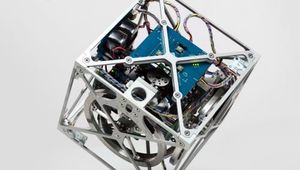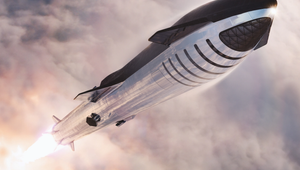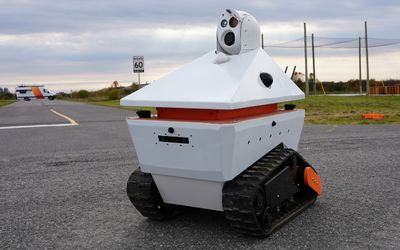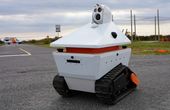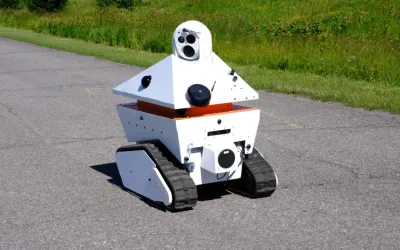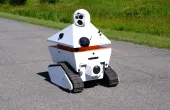AgileX Bunker
An all-terrain crawler-type UGV by AgileX features differential mechanism and forward tilt track design with <36° climbing grade and 170mm max obstacle height for terrain adaptability.
Technical Specifications
| Dimensions | 1023L x 778W x 400H mm |
| Wheelbase | 360mm |
| Track width | 150mm |
| Weight | 145-150kg |
| Rated Travelling Load | 80kg |
| Rated Spin Load | 60kg |
| Speed | 5 km/h |
| Communication | Standard CAN |
| Remote Control | |
| 2.4G/extreme distance 1km | |
| Gyroscope | 9-Axis Gyroscope 0.01° Resolution |
| Operating Temp | -10~ 45° C |
| IP Rating | IP54 |
| Drive Type | Left and Right Independent Drive |
| Track Differential Steering | |
| Shock Absorber | Left and Right Independent * 6 Shock Absorbers |
| Suspension | Christie Suspension |
| Max Obstacle Height | 170mm |
| Climbing Grade | <36° With Load |
| Min Turning Radius | 0mm (In-Place/In-situ Rotation) |
| Minimum Ground Clearance | 90mm |
| Motors | 2 x 650W Brushless Servo Motor |
| Encoder | 1024 Lines Photoelectric Incremental Code Wheel |
| Battery | Standard: 48V/30Ah |
| Optional: 48V/60Ah | |
| Max Travel (No Load) | 10km |
| Charge Time | 6~7H |
| Charger | AC220V Independent Charger |
Overview
Unmanned Ground Vehicles (UGVs) are a set of vehicles functioning on the ground without requiring human presence on board. UGV is enormously beneficial in risky situations requiring safety, such as detonation, exploration, rescue, and research. However, for rugged terrain, locomotion through tracks seems to be the best option, but they are less efficient and slower, cause more vibration, and require more mechanical complexity.
BUNKER, a multi-purpose track chase, is applicable in various applications—from simple and sensitive operations to large development spaces. It can adapt to different development fields and applications and independent suspension systems. It likewise features a climbing ability and a high payload.
AgileX Robotics' BUNKER is suitable in special working environments, with its differential rotation, minimal mechanical loss, robust load capacity, and improved ingress protection rating. It also has pressing applications in special robot development, from inspection and exploration, special shooting and transportation, and mobile grabbing to rescue and detonation, among many others.
Design
BUNKER, with an IP54 rating, measures 1023 x 778 x 400 mm and weighs 145-150 kg. The track width is 150mm, and the wheelbase is 360mm. IT can carry a traveling load of 80kg and a spin load of 60kg. The Controller Area Network (CAN) allows 2.4G remote control of BUNKER over a 1km distance. The 48V/30Ah battery powers the device up to 10 km travel at 5km/h without load. An AC220V independent charger can charge BUNKER for about 6-7 hours.
Hardware
BUNKER runs through a track differential sterling drive type with a left and right independent drive. It boasts two 650W Brushless Servo Motors and a photoelectric incremental code wheel of 1024 lines encoder type. The six shock absorbers of the Christie suspension give the platform stability and lets it adapt to rough terrain.
BUNKER can climb slopes and step with its forward tilt track design. It has a climbing grade of <36° with loads on and can climb a maximum obstacle height of 170 mm with a minimum ground clearance of 90mm. It can rotate in place (in-situ rotation) with a minimum turning radius of 0mm. BUNKER has a 9-axis gyroscope with a 0.01° resolution.
Expansion
BUNKER offers customization for various advanced operation modes. It has aluminum T-slot rails on the top, providing a standardized mounting solution. These rails are convenient when securely mounting equipment, sensors, preconfigured R&D, and navigation kits. There are also side rails for quick building top load, such as industrial control, IMU, camera, routing, sensing, and others.
BUNKER supports the customized sensor aIuminum profile bracket design and has access to advanced automatic driving systems, like Apollo and ROS. BUNKER uses CAN as it interfaces with external devices, and C++ and ROS packages for further secondary development.
Packages
A battery expansion of 60Ah is available for BUNKER, which can significantly increase the 10km maximum distance covered by the 48V30Ah default battery.
The fully integrated AgileX R&D solution, designed for robotics research and development, has a full suite of sensors supporting navigation, indoor SLAM, and vision-based application. It also features an Nvidia Jetson Nano computer with Linux Ubuntu 18.04 & ROS Melodic pre-installed software. Other devices include an Intel RealSense depth camera, WiFi module, LCD, and EAI G4 LiDAR.
The R&D Pro package is similar to the standard kit, except for its Nvidia Xavier computer and not to mention the Velodyne Puck LiDAR.
A hardware-software solution enabling autonomous navigation is the AgileX Autopilot Kit, which also provides path planning and avoids obstacles without needing preloaded maps. It comes with various sensors, devices, and computers, including high-precision LiDAR, Pixhawk 4 controller, binocular and depth cameras, and RTK GPS antenna.
AgileX AutoKit, based upon the Autoware open-source software, is a full-stack driving development and education kit at a cost-effective price. It gives a powerful autonomous driving sensor, which integrates seamlessly into the robot platform. An 8-core 32GB RAM computer, LCD, Robotsense 16 channel LiDAR, and a USB-to-CAN module are some of the sensors, devices, and computers that come with the AutoWare Kit.
Software
The open-source Robot Operating System (ROS) is a middleware suite for robot software development. It is not an OS but a software framework collection that provides various functions for a heterogeneous cluster. The cluster includes low-level device control, hardware abstraction, package management, and others.
The Controller Area Network (CAN bus) allows communication between microcontrollers and devices without a host computer. While it is initially built for multiplex electrical wiring in automobiles for saving copper, this message-based protocol is also applicable in a variety of contexts. AgileX CAN bus protocol allows users to communicate over CAN.
